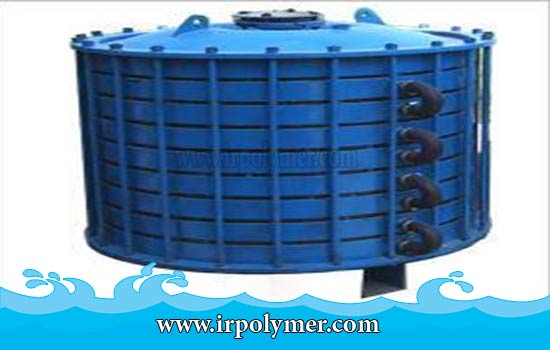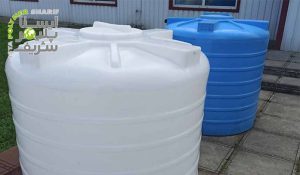Glass-Lined Storage Tanks are a type of tank, and what does glass lining mean? In corrosive environments, materials that are highly resistant to corrosive substances must be used. Essentially, resistant coatings are applied to store corrosive materials.
What is Glass?
Glass, or more specifically, the glassy material, is important due to its crystalline chemical structure and high chemical resistance in corrosive environments, as well as its lower cost compared to titanium, which has similar chemical resistance properties. Therefore, considering these advantages, it is used for the internal coating of equipment due to its economic efficiency. This glass lining is used in critical and strategic equipment. In many cases, using glass-lined tanks is the only solution for production.
Types of Applied Coatings
- Metallic coatings
- Inorganic coatings (ceramic, enamel, glass)
- Organic coatings (paint, rubber, fluoropolymers)
Production of Glass-Lined Equipment
- Types of glass-lined chemical reactors
- Glass-lined storage tanks
- Pressure vessels
- Very large silos
- Chemical towers
- Dryers
- Various heat exchangers
- Pipes, fittings, and valves
- Mixers and baffles
Tanks containing acid and other corrosive materials require corrosion protection with a long service life. Corrosion leads to additional costs for repairs. Glass-lined tanks are coated with glass enamel, and these tanks can be produced as pressure vessels or atmospheric tanks. The product is made from a combination of glass with acid resistance and iron with excellent mechanical properties.
Glass-Lined Reactors
Glass-lined reactors must have a smooth and polished interior surface that allows for easy cleaning, with no corrosion and low pressure. The use of glass-coated stainless steel provides excellent resistance to sticky products, making cleaning easier. When high corrosion and chemical resistance and high purity are required, careful selection of materials for the equipment is essential; glass is the best option for these features. Composite materials consisting of glass and metal are used in the construction of glass-lined reactors, with a completely smooth surface and corrosion protection.

Type CE Reactor
These reactors consist of a nozzle, manhole, and mixer inlet. The capacity for this type is 1600 liters. For high pressure, it is possible to install a mixer inside the reactor.
Type BE Reactor
In addition to the nozzle and manhole which are also found in Type CE, it includes a turbine mixer.
Type AE Reactor
This type of reactor has a larger capacity than the previous two types, with up to 6300 liters capacity. The mixer can be installed on the reactor. Its mobility means that the upper dome of the glass-lined reactor is made separately from the tank.
Glass-Lined Heat Exchanger
Heat exchangers are highly efficient and must be completely resistant; their role is to convert the gas phase into the liquid phase. Heat exchangers are also used for changing the temperature of corrosive fluids. There are various types of heat exchangers, including:
- Silicon carbide heat exchangers
- Glass-lined heat exchangers
- Stainless steel heat exchangers
Applications of Glass-Lined Heat Exchangers
-
- Chemical factories
- Power plants
- Desulfurization systems in flue gases
- Industrial combustion plants
Glass-lined heat exchangers are widely used due to their thin coating layer, seamless connections, and complete sealing. For the design of glass-lined heat exchangers, the coating thickness can be up to 2 mm, and its impact on heat transfer should be evaluated. Glass-lined exchangers require a larger surface area to reduce heat transfer compared to stainless steel. Due to the microscopic nature of the coating connections, glass-lined heat exchangers can have higher efficiency compared to other types.
Heat exchangers can be installed horizontally or vertically. The operating temperature is up to 220°C. Helium leak testing is conducted to ensure sealing. Due to the high chemical resistance and corrosion resistance of materials like glass, using glass-lined heat exchangers that are resistant to corrosive substances and acids is essential.
Glass-Lined Cooling Towers
The function of cooling towers is to absorb unusable and excess heat from water in industrial systems and transfer it to the atmosphere; in other words, they handle thermal exchange with air. These towers are among the most important equipment in the chemical industry. They can be designed as either open or closed loop systems. The main issues in such towers are internal corrosion, algae and biological bacteria growth, and ultimately scaling, which need to be addressed.
Therefore, to resist corrosion when exposed to acids and corrosive materials, the use of glass-lined cooling towers is the best choice due to the inherent corrosion resistance of glass. They can be manufactured in any capacity and design for specific processes. For example, they can be designed and produced with angled configurations. Depending on their size, they can be connected with auxiliary equipment such as flanges and clamps to achieve a completely sealed structure. These towers can be supplied as packages or constructed on-site. When using glass lining, they can be confidently used in contact with corrosive materials without causing damage.






